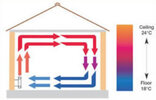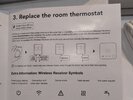I'm creating a new thread as my previous one doesn't quite touch on what I'm potentially now needing to do. This is the old one (that has photos of my wired thermostat wiring):

 www.diynot.com
www.diynot.com
I have a Timeguard 3 Channel Programmer that controls heating on the 1st and 2nd floor using two seperate wired thermostats (one on each floor) and then the hot water tank. I've been thinking about replacing them with the Tado for a while and then this week the 2nd floor thermostat stopped working. It actually stops the heating coming on upstairs so I either need to replace it or take the plunge and replace the whole system.
I'm leaning towards the Tado Wireless V3+ kit (only £85 from Screwfix just now plus I have a £10 voucher) plus an extra temperature sensor (unless you can pair wired Tado thermostats with the wireless kit?). However, I'm confused whether the existing 1st floor wired thermostat (the working one) and the 2nd floor thermostat (the malfunctioning one) will cause issues if I just leave them as is? I'd like to leave them as is for now to be honest. The alternative is that I buy two wired Tado thermostats to replace the existing ones but still use the wireless receiver from the Wireless V3+ kit to replace the Timeguard 3 channel programmer but I'm not sure if the wired Tado thermostats work with the wireless kit?

How to thermostats work
Hi all, I have a gas boiler than is for underfloor heating and hot water (on demand) on the ground floor, heating and a hot water tank on the first floor, and then heating on the second floor. The first and second floor heating and the hot water tank are managed by a Timeguard TRT038N 3...
 www.diynot.com
www.diynot.com
I have a Timeguard 3 Channel Programmer that controls heating on the 1st and 2nd floor using two seperate wired thermostats (one on each floor) and then the hot water tank. I've been thinking about replacing them with the Tado for a while and then this week the 2nd floor thermostat stopped working. It actually stops the heating coming on upstairs so I either need to replace it or take the plunge and replace the whole system.
I'm leaning towards the Tado Wireless V3+ kit (only £85 from Screwfix just now plus I have a £10 voucher) plus an extra temperature sensor (unless you can pair wired Tado thermostats with the wireless kit?). However, I'm confused whether the existing 1st floor wired thermostat (the working one) and the 2nd floor thermostat (the malfunctioning one) will cause issues if I just leave them as is? I'd like to leave them as is for now to be honest. The alternative is that I buy two wired Tado thermostats to replace the existing ones but still use the wireless receiver from the Wireless V3+ kit to replace the Timeguard 3 channel programmer but I'm not sure if the wired Tado thermostats work with the wireless kit?



